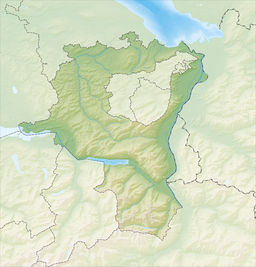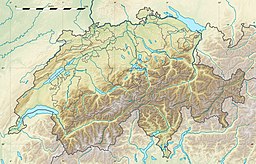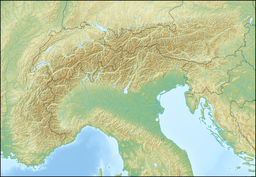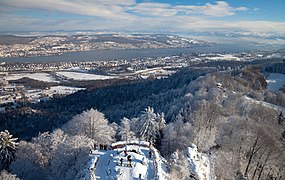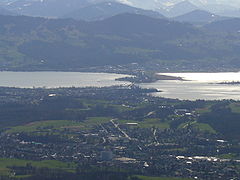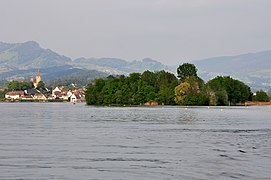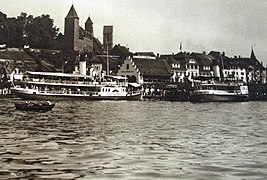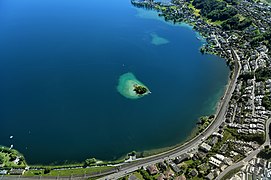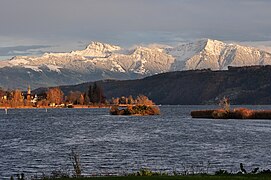Lake Zurich
| Lake Zurich | |
|---|---|
| Zürichsee (German) | |
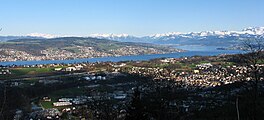 Lake Zurich, Pfannenstiel, and Sihl Valley, as seen from Felsenegg | |
 | |
| Coordinates | 47°14′51″N 8°40′39″E / 47.24750°N 8.67750°E |
| Primary inflows | Linth (Linthkanal) |
| Primary outflows | Limmat |
| Catchment area | 1,829 km2 (706 sq mi) |
| Basin countries | Switzerland |
| Max. length | 40 kilometres (25 miles) |
| Max. width | 3 kilometres (2 miles) |
| Surface area | 88.66 square kilometres (34.23 square miles) |
| Average depth | 49 metres (161 feet) |
| Max. depth | 136 metres (446 feet) |
| Water volume | 3.9 km3 (0.94 cu mi) |
| Residence time | 440 days |
| Surface elevation | 406 m (1,332 ft) |
| Frozen | 1929, 1962/1963 (last) |
| Islands | Lützelau, Schönenwerd, Saffa, Ufenau |
| Sections/sub-basins | Obersee |
| Settlements | see list |
 | |
Lake Zurich (German: Zürichsee; Swiss German/Alemannic: Zürisee)[1] is a lake in Switzerland, extending southeast of the city of Zürich. Depending on the context, Lake Zurich or Zürichsee can be used to describe the lake as a whole, or just that part of the lake downstream of the Hurden peninsula and Seedamm causeway (between Pfäffikon and Rapperswil). In the latter case, the upstream part of the lake is called Obersee (lit. 'Upper Lake'), whilst the lower part is sometimes also referred to as the Lower Lake (unterer Zürichsee), respectively.
Geography[edit]
Lake Zurich was formed by the Rhine-Linth glacier. Its main tributary is the River Linth, which rises in the glaciers of the Glarus Alps. The Linth originally flew directly into Lake Zurich, but was later diverted by the Escher canal (completed in 1811) into Lake Walen from where its waters are now carried to the east end of Lake Zurich (near Schmerikon) by means of the straightened Linth canal (completed in 1816). Until the early 16th century, there was another lake upstream of Obersee, Lake Tuggen near Tuggen. The waters of Lake Zurich flow out of the lake at its north-west end (at the level of the Quaibrücke), passing through the city of Zürich; however, the outflow is then called the Limmat. The Limmat is a tributary of the Aare, which itself is a tributary of the High Rhine.[2] The culminating point of the lake's drainage basin is the Tödi at 3,614 metres above sea level.[3]
Besides the River Linth, other tributaries are the Jona, Schmerikoner Aa, Steinenbach and Wägitaler Aa, which all flow out into Obersee, along with several creeks.[2] The Seedamm, an artificial causeway and bridge, crosses the narrowest point of the lake at the level of the Hurden Peninsula, carrying a railway line and road from Rapperswil to Pfäffikon. The waterway is also crossed by the Holzbrücke Rapperswil-Hurden, a wooden pedestrian bridge. The eastern section of the lake is known as the Obersee (lit. 'Upper Lake'). West of the Seedamm lie the small islands of Lützelau and Ufenau, where in 1523 Ulrich von Hutten took refuge and died. Other islands include Grosser Hafner, Saffa Island and Schönenwerd (near Richterswil). A popular tourist destination is the Au peninsula at the village of Au between Wädenswil and Horgen. The lake shores are well cultivated and fertile.[2] They include nature reserves, such as Frauenwinkel or Bätzimatt. The bay of Rapperswil and reed in Nuolen are wintering areas for birds and popular sites for bird watching.
To the east, separated by Zürichberg-Adlisberg, Forch, and Pfannenstiel, are two smaller lakes, Greifensee (lit. 'Lake Greifen') and Pfäffikersee (lit. 'Lake Pfäffikon'). There are several minor lakes and ponds in the vicinity, such as Egelsee, Lützelsee or Türlersee. Zimmerberg, Etzel and Buechberg mountains lie to the west and south of the lake, respectively. Further to the east, the Speer, Chüemettler and Federispitz can be seen from the southern part of the lake.
Administratively, Lake Zurich is split between the cantons of Zürich (Horgen District), St. Gallen (See-Gaster) and Schwyz (Höfe and March districts). The lower lake, to the west of the Seedamm, is largely in the canton of Zürich, whilst the upper lake is shared between the cantons of St. Gallen and Schwyz.
Tributaries of lower lake[edit]
The following rivers or streams flow into lower part of Lake Zurich.[4] From the Limmat clockwise, they are:
- Hornbach (at Zürichhorn)
- Düggelbach (at Zollikon)
- Kusenbach (at Küsnacht)
- Küsnachter Dorfbach (at Hornelanpark, Küsnacht)
- Heslibach (at Erlenbach)
- Dorfbach Erlenbach (at Erlenbach)
- Tobelbächli (at Erlenbach)
- Schipfbach (at Erlenbach)
- Rossbach (at Herrliberg)
- Meilener Dorfbach (at Meilen)
- Beugenbach (at Meilen)
- Aebletenbach (at Ländeli, Meilen)
- Uetiker Mulibach (at Meilen)
- Feldbach (at Horn)
- Sarenbach (at Freienbach)
- Krebsbach (at Bäch, Freienbach)
- Mülibach (at Richterswil)
- Zürichsee (at Wädenswil)
- Meilibach (at Wädenswil)
- Schanzengraben (Zürich)
Coastal settlements[edit]
Zürich, at the north-western end of the lake, is the largest city on Lake Zurich. The least populous is Hurden.
On the west shore (which gradually becomes the south shore) are Kilchberg, Rüschlikon, Thalwil, Oberrieden, Horgen, Au, Wädenswil and Richterswil in the canton of Zürich, and Freienbach, Pfäffikon, Hurden, Altendorf, Lachen, Nuolen and Tuggen in the canton of Schwyz.
On the opposite shore, which gradually becomes the northern shore towards east, are Zollikon, Küsnacht, Erlenbach, Herrliberg, Feldmeilen, Meilen, Stäfa, and Feldbach in the canton of Zürich, and Rapperswil-Jona. The latter includes the medieval town of Rapperswil, whose castle is home to the Polish museum, and the coastal villages of Kempraten, Busskirch and Bollingen. The municipalities of Rapperswil-Jona and Schmerikon, which is close to the east end of the lake, are both in the canton of St. Gallen. A little further east is the larger town of Uznach.

Prehistoric pile dwellings and historic settlements[edit]
Nine Prehistoric pile dwellings around Zürichsee, which are located in the cantons of Schwyz, St. Gallen and Zürich, are among the 56 Prehistoric pile dwellings around the Alps in Switzerland.[5][6]
These nine sites on the Lake Zurich lakeshore are Freienbach–Hurden Rosshorn, Freienbach–Hurden Seefeld, Rapperswil-Jona/Hombrechtikon–Feldbach, Rapperswil-Jona–Technikum, Erlenbach–Winkel, Meilen–Rorenhaab, Wädenswil–Vorder Au, Zürich–Enge Alpenquai, and Kleiner Hafner. Because the lake has grown in size over time, the original piles are now around 4 metres (13 ft) to 7 metres (23 ft) under the water level of 406 metres (1,332 ft). Two other sites are not far away: Greifensee–Storen/Wildsberg at the Greifensee and Wetzikon–Robenhausen at the Pfäffikersee.
As well as being part of the 56 Swiss sites of the UNESCO World Heritage Site, each of these 11 prehistoric pile dwellings is also listed as a Class object in the Swiss inventory of cultural property of national and regional significance.[7]
In Kempraten (Rapperswil-Jona municipality), there was a Roman vicus named Centum Prata. Another settlement was Turicum in Zürich.
Transportation[edit]
The main transportation nodes around the lake are Zürich and — given the presence of the Seedamm causway — Pfäffikon and Rapperswil. Besides Quaibrücke in Zürich and the Seedamm, there are no bridges across the lake. In addition, the towns of Meilen and Horgen are connected by a car ferry.
Bus[edit]
Bus routes on the western shore are operated by Zimmerberg Bus. On the eastern side, the VZO provides bus services along the lake shore and to the Zürcher Oberland.
Rail[edit]
The towns on the western and southern shores of Lake Zurich are linked by the Lake Zurich left bank railway line, which connects Zürich HB with Ziegelbrücke. This line is served by the S2, S8, S24 and S25 of the Zürich S-Bahn and InterRegio (IR) trains. It is also used by Intercity (IC), Intercity Express (ICE) and Railjet (RJX) trains but they do not call at stations along the lake. At Wädenswil, the line connects to the Wädenswil–Einsiedeln railway to Einsiedeln, served by the S13.
Towns on the eastern shore of the lower lake (also known as the Goldcoast, or Goldküste) are connected by the Lake Zurich right bank railway line between Zürich HB and Rapperswil. This line is served by S-Bahn services S6, S7, S16 and S20 of Zürich S-Bahn.
The Rapperswil–Ziegelbrücke railway line along the northern shore of Obersee is served by St. Gallen S-Bahn services S4, S6 and S17, and the Voralpen Express. This line connects Rapperswil with Schmerikon on the eastern end of the lake via Blumenau. Bollingen is a ghost station since 2004.
The Rapperswil–Pfäffikon railway line across the Seedamm and Hurden Peninsula is served by Zürich S-Bahn services S5 and S40 and the Voralpen Express. This short line connects Rapperswil with Pfäffikon SZ via Hurden.
Shipping[edit]
The Zürichsee-Schifffahrtsgesellschaft – lit. 'the Lake Zurich Navigation Company' – provides with its 17-passenger ships touristic services on Lake Zurich. There are a number of passenger ferry services, notably the Horgen–Meilen ferry, an auto ferry between Horgen and Meilen.
Freezing[edit]

The lake was frozen in the following Common Era/Anno Domini years:
- 1223, 1259, 1262
- 1407, 1491
- 1514, 1517, 1573
- 1600, 1660, 1684, 1695
- 1709, 1716, 1718, 1740, 1755, 1763, 1789
- 1830, 1880, 1891, 1895
- 1929, 1963
Water quality[edit]
Lake Zurich's water is very clean and reaches, during summer, temperatures well beyond 20 °C (68 °F). Swimming in the public baths and beaches is very popular. The lake's water is purified and fed into Zürich's water system; it is potable.

Gallery[edit]
-
View from the top of the observation tower at Uetliberg.
-
View from Felsenegg to the eastern part of Lake Zürich
-
Ufenau island
-
Lützelau and Rapperswil, view from Ufenau island
-
Zurisee from an airplane
-
Schönenwerd island near Richterswil
-
Bank path and pedestrian bridge near Richterswil
-
Wooden pedestrian bridge near Rapperswil
-
Small islands near Jona delta
See also[edit]
- Obersee (Zürichsee)
- Prehistoric pile dwellings around Zürichsee
- Paddle steamer Stadt Rapperswil
- Paddle steamer Stadt Zürich
- Radio Zürisee
- Seedamm
- Zürichsee-Zeitung
References[edit]
- ^ "National Map 1:50 000" (Map). Zürichsee (2011 ed.). 1:50 000. "National Map 1:50'000, 78 sheets and 25 composites". Bern, Switzerland: Swiss Federal Office of Topography, swisstopo. 16 January 2014. § "5011 Zürichsee - Zug". ISBN 978-3-302-05011-9. Retrieved 2014-12-01.
- ^ a b c One or more of the preceding sentences incorporates text from a publication now in the public domain: Coolidge, William Augustus Brevoort (1911). "Zürich, Lake of". In Chisholm, Hugh (ed.). Encyclopædia Britannica. Vol. 28 (11th ed.). Cambridge University Press.
- ^ "National Map 1:25 000" (Map). Tödi, Lake Zurich's culmination point (2009 ed.). 1:25 000. "National Map 1:25'000, 247 sheets and 17 composites". Bern, Switzerland: Swiss Federal Office of Topography, swisstopo. 16 January 2014. § "1193 Tödi". ISBN 978-3-302-05011-9. Retrieved 2014-12-01.
- ^ Bradshaw's pedestrian route-book for Switzerland, Chamouni, and the Italian lakes, George Bradshaw (1868)
- ^ "Prehistoric Pile Dwellings in Switzerland". Swiss Coordination Group UNESCO Palafittes (palafittes.org). Archived from the original on 2014-10-07. Retrieved 2014-12-07.
- ^ "World Heritage". palafittes.org. Archived from the original on 2014-12-09. Retrieved 2014-12-10.
- ^ "A-Objekte KGS-Inventar". Schweizerische Eidgenossenschaft, Amt für Bevölkerungsschutz. 2009. Archived from the original on 2010-06-28. Retrieved 2014-12-10.
External links[edit]
- Peter Ziegler: Zürichsee in German, French and Italian in the online Historical Dictionary of Switzerland, 28 February 2014.
- Zürichsee Schifffahrtsgesellschaft—Boat schedules, mainly non-English.
- Zürichsee-Fähre Horgen-Meilen—Ferry schedules, in German.
- Waterlevels Lake Zürich at Zürich
- Lake Zurich ENC Chart



